曼昆《宏观经济学》(第9版)章节习题精编详解-第1~2篇【圣才出品】
- 格式:pdf
- 大小:2.36 MB
- 文档页数:154
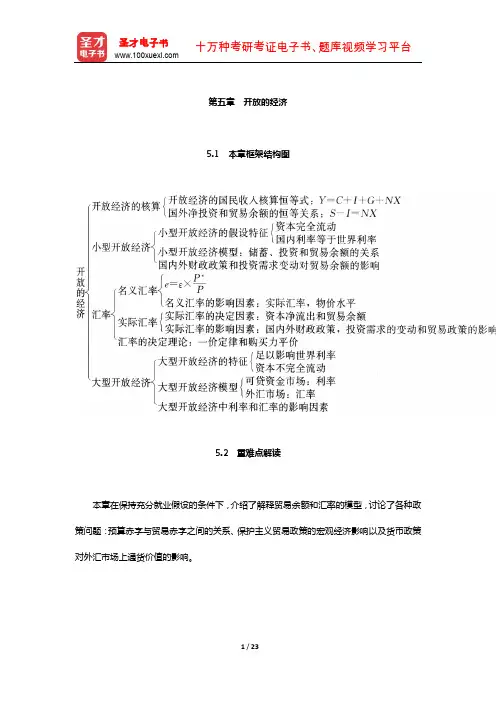
第五章开放的经济5.1 本章框架结构图5.2 重难点解读本章在保持充分就业假设的条件下,介绍了解释贸易余额和汇率的模型,讨论了各种政策问题:预算赤字与贸易赤字之间的关系、保护主义贸易政策的宏观经济影响以及货币政策对外汇市场上通货价值的影响。
一、资本与产品的国际流动1.开放经济中的国民经济核算恒等式开放经济中的国民收入核算恒等式为:Y=C d+I d+G d+EX=C d+I d+G d+EX-IM+IM=(C d+C f)+(I d+I f)+(G d+G f)+(EX-IM)=C+I+G+NX该方程表明:在国内产出上的支出是消费、投资、政府购买以及净出口之和。
2.国际资本流动与贸易余额由开放经济下的国民收入核算恒等式Y=C+I+G+NX以及国民储蓄S=Y-C-G可得:S-I=NX(1)S-I表示国内储蓄和国内投资的差额,称为资本净流出,又称国外净投资,可正可负,反映资本市场的资金情况。
(2)NX=出口-进口,称为净出口或称为贸易余额,可正可负,反映国家间产品和服务市场的流动情况。
当出口大于进口时,净出口为正,此时贸易盈余,国内产出大于国内支出;反之,贸易赤字;如果出口正好等于进口,净出口为零,国内产出等于国内支出,则贸易平衡。
恒等式S-I=NX表明资本净流出恒等于贸易余额。
二、小型开放经济的一般均衡模型1.小型开放经济的两个显著特点(1)资本完全流动,即小型开放经济体中的家庭和企业可以不受政府干预地自由进入世界金融市场进行资产的买卖,从而导致了资本流入和资本流出。
(2)本国实际利率等于世界利率,即r=r*,世界利率由世界储蓄和世界投资的均衡决定。
小型开放经济由于经济体太小,其在国际金融市场上的活动对世界利率不产生影响,这就意味着小型开放经济的利率由世界利率外生给定,不能起到通过调整投资使国内储蓄等于国内投资的作用。
2.小型开放经济的一般均衡模型(1)模型的三个假设条件:①产出Y由生产要素和生产函数固定,即Y=Y_=F(K_,L_),所以该经济产出固定;②消费函数为C=(Y-T),消费和可支配收入Y-T正相关;③投资I和实际利率r负相关,投资函数为I=I(r)。
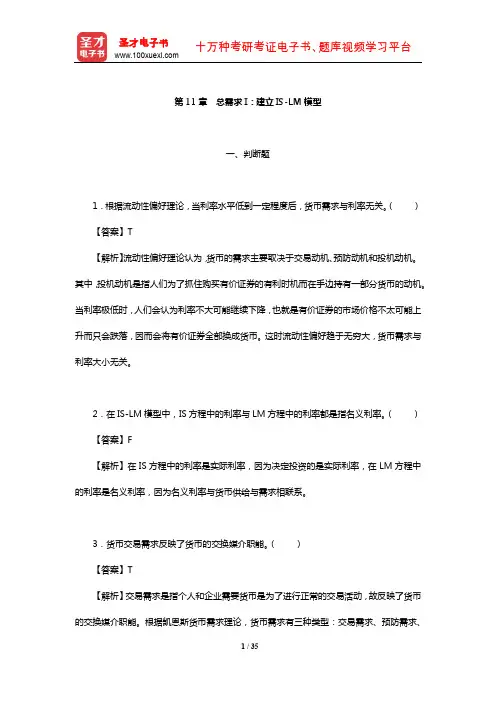
第11章总需求I:建立IS-LM模型一、判断题1.根据流动性偏好理论,当利率水平低到一定程度后,货币需求与利率无关。
()【答案】T【解析】流动性偏好理论认为,货币的需求主要取决于交易动机、预防动机和投机动机。
其中,投机动机是指人们为了抓住购买有价证券的有利时机而在手边持有一部分货币的动机。
当利率极低时,人们会认为利率不大可能继续下降,也就是有价证券的市场价格不太可能上升而只会跌落,因而会将有价证券全部换成货币。
这时流动性偏好趋于无穷大,货币需求与利率大小无关。
2.在IS-LM模型中,IS方程中的利率与LM方程中的利率都是指名义利率。
()【答案】F【解析】在IS方程中的利率是实际利率,因为决定投资的是实际利率,在LM方程中的利率是名义利率,因为名义利率与货币供给与需求相联系。
3.货币交易需求反映了货币的交换媒介职能。
()【答案】T【解析】交易需求是指个人和企业需要货币是为了进行正常的交易活动,故反映了货币的交换媒介职能。
根据凯恩斯货币需求理论,货币需求有三种类型:交易需求、预防需求、投机需求。
4.实际货币供给增加可以通过价格水平的提高或者是名义货币供给的增加来达到。
( )【答案】F【解析】实际货币供给m =M/P ,这里M 是名义货币供给,M 增加时m 是增加的。
但是,当价格水平P 提高时,实际货币m 减少。
5.在不存在所得税的情况下,政府购买增加,同时转移支付等量减少,则国民生产总值的增加量即为政府增加的购买量( )。
【答案】T【解析】政府购买乘数为:1/(1-MPC ),转移支付乘数为:MPC/(1-MPC ),政府购买增加与转移支付等量减少,则111MPC Y G G G MPC MPC ∆=⋅∆-⋅∆=∆--6.如果在一个新的联邦预算中的人均政府购买提高了100美元,并且通过一项新的每人100美元的居民人均税支付它,这样政府赤字没有改变,中央银行使利率保持不变,这样GDP 也不会改变。
( )【答案】F【解析】平衡预算乘数是1。
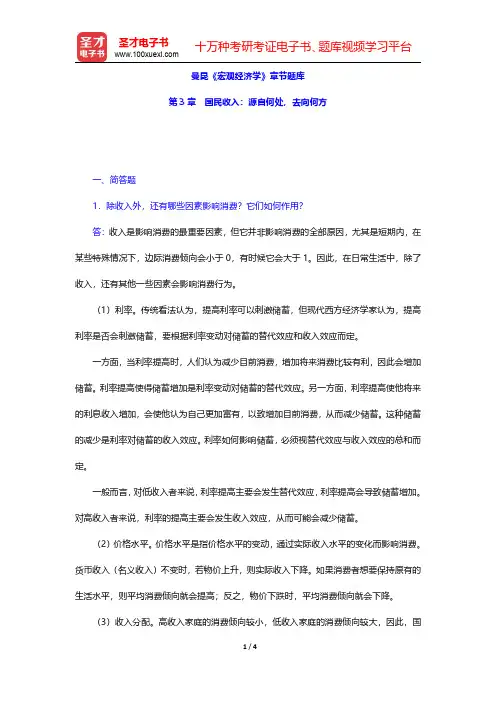
曼昆《宏观经济学》章节题库第3章国民收入:源自何处,去向何方一、简答题1.除收入外,还有哪些因素影响消费?它们如何作用?答:收入是影响消费的最重要因素,但它并非影响消费的全部原因,尤其是短期内,在某些特殊情况下,边际消费倾向会小于0,有时候它会大于1。
因此,在日常生活中,除了收入,还有其他一些因素会影响消费行为。
(1)利率。
传统看法认为,提高利率可以刺激储蓄,但现代西方经济学家认为,提高利率是否会刺激储蓄,要根据利率变动对储蓄的替代效应和收入效应而定。
一方面,当利率提高时,人们认为减少目前消费,增加将来消费比较有利,因此会增加储蓄。
利率提高使得储蓄增加是利率变动对储蓄的替代效应。
另一方面,利率提高使他将来的利息收入增加,会使他认为自己更加富有,以致增加目前消费,从而减少储蓄。
这种储蓄的减少是利率对储蓄的收入效应。
利率如何影响储蓄,必须视替代效应与收入效应的总和而定。
一般而言,对低收入者来说,利率提高主要会发生替代效应,利率提高会导致储蓄增加。
对高收入者来说,利率的提高主要会发生收入效应,从而可能会减少储蓄。
(2)价格水平。
价格水平是指价格水平的变动,通过实际收入水平的变化而影响消费。
货币收入(名义收入)不变时,若物价上升,则实际收入下降。
如果消费者想要保持原有的生活水平,则平均消费倾向就会提高;反之,物价下跌时,平均消费倾向就会下降。
(3)收入分配。
高收入家庭的消费倾向较小,低收入家庭的消费倾向较大,因此,国民收入分配越是平均,全国性的平均消费倾向就会越大,而收入分配越是不平均,则全国性的平均消费倾向就会越小。
(4)社会保障制度。
一般来说,社会保障制度越是完善,居民越是敢于消费,否则储蓄意愿要增强。
2.假设消费者信心提高增加了消费者未来收入的预期,从而他们现在想消费的数量增加。
可以把这种情况解释为消费函数向上移动。
这种移动如何影响投资和利率?答:如果消费者增加现期的消费数量,那么私人储蓄和国民储蓄将下降。
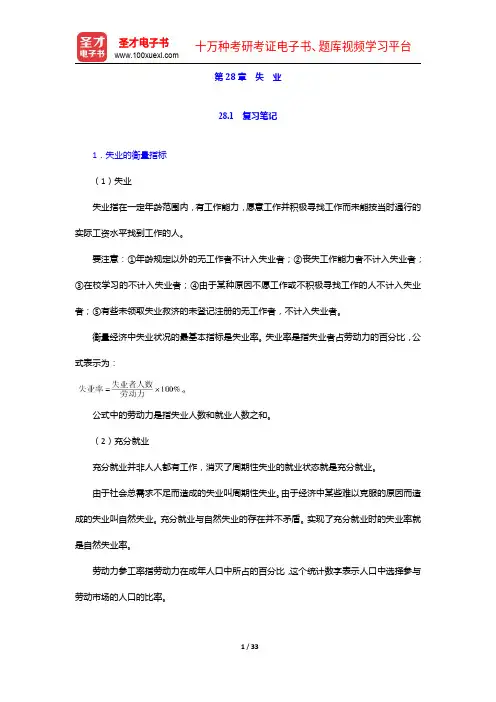
第28章失业28.1复习笔记1.失业的衡量指标(1)失业失业指在一定年龄范围内,有工作能力,愿意工作并积极寻找工作而未能按当时通行的实际工资水平找到工作的人。
要注意:①年龄规定以外的无工作者不计入失业者;②丧失工作能力者不计入失业者;③在校学习的不计入失业者;④由于某种原因不愿工作或不积极寻找工作的人不计入失业者;⑤有些未领取失业救济的未登记注册的无工作者,不计入失业者。
衡量经济中失业状况的最基本指标是失业率。
失业率是指失业者占劳动力的百分比,公式表示为:公式中的劳动力是指失业人数和就业人数之和。
(2)充分就业充分就业并非人人都有工作,消灭了周期性失业的就业状态就是充分就业。
由于社会总需求不足而造成的失业叫周期性失业。
由于经济中某些难以克服的原因而造成的失业叫自然失业。
充分就业与自然失业的存在并不矛盾。
实现了充分就业时的失业率就是自然失业率。
劳动力参工率指劳动力在成年人口中所占的百分比,这个统计数字表示人口中选择参与劳动市场的人口的比率。
经济中总存在某种失业,而且各年的失业量都在变动。
失业率围绕正常失业率而波动。
正常失业率称为自然失业率,失业率与自然失业率的背离称为周期性失业。
(3)失业率不能准确地衡量失业的原因①一些人只是为了能得到政府的福利或由于得到“暗中”支付而装作找工作,他们仍被算在劳动力之中,作为失业者。
这种行为使失业统计数字偏高。
②一些人寻找工作不成功,并放弃了寻找工作,因此他们未被算在失业者之内。
这种行为使失业统计数字偏低。
2.失业的分类宏观经济学通常将失业分为三种类型,即摩擦性失业、结构性失业以及周期性失业。
(1)摩擦性失业指劳动力在正常流动过程中所产生的失业。
摩擦性失业量的大小取决于劳动力流动性的大小和寻找工作所需要的时间。
由于在动态经济中,劳动力的流动是正常的,所以摩擦性失业的存在也是正常的。
(2)结构性失业指劳动力的供给和需求不匹配所造成的失业,其特点是既有失业,又有职位空缺,失业者或者没有合适的技能,或者居住地点不当,因此无法填补现有的职位空缺。
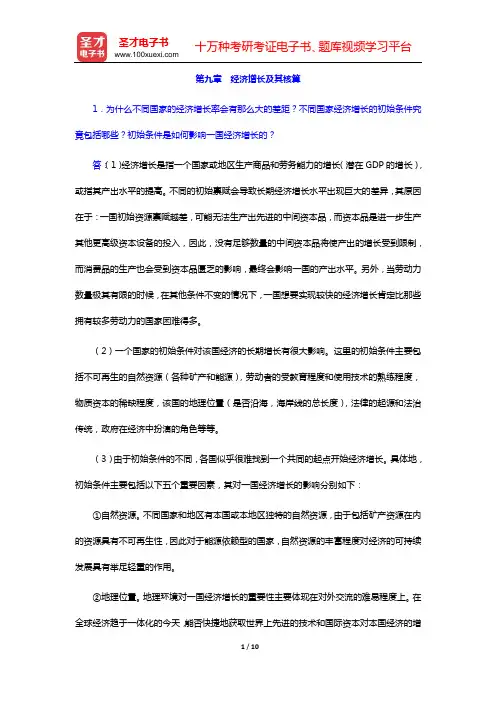

曼昆宏观经济经济学第九版英文原版答案3(总13页)--本页仅作为文档封面,使用时请直接删除即可----内页可以根据需求调整合适字体及大小--Answers to Textbook Questions and ProblemsCHAPTER3?National Income: Where It Comes From and Where It Goes Questions for Review1. The factors of production and the production technology determine theamount of output an economy can produce. The factors of production are the inputs used to produce goods and services: the most important factors are capital and labor. The production technology determines how much output can be produced from any given amounts of theseinputs. An increase in one of the factors of production or animprovement in technology leads to an increase in the economy’soutput.2. When a firm decides how much of a factor of production to hire ordemand, it considers how this decision affects profits. For example, hiring an extra unit of labor increases output and thereforeincreases revenue; the firm compares this additional revenue to the additional cost from the higher wage bill. The additional revenue the firm receives depends on the marginal product of labor (MPL) and the price of the good produced (P). An additional unit of labor produces MPL units of additional output, which sells for P dollars per unit.Therefore, the additional revenue to the firm is P ? MPL. The cost of hiring the additional unit of labor is the wage W. Thus, this hiring decision has the following effect on profits:ΔProfit= ΔRevenue –ΔCost= (P ? MPL) –W.If the additional revenue, P ? MPL, exceeds the cost (W) of hiring the additional unit of labor, then profit increases. The firm will hire labor until it is no longer profitable to do so—that is, until the MPL falls to the point where the change in profit is zero. In the equation abov e, the firm hires labor until ΔP rofit = 0, which is when (P ? MPL) = W.This condition can be rewritten as:MPL = W/P.Therefore, a competitive profit-maximizing firm hires labor until the marginal product of labor equals the real wage. The same logicapplies to the firm’s decision regarding how much capital to hire:the firm will hire capital until the marginal product of capitalequals the real rental price.3. A production function has constant returns to scale if an equalpercentage increase in all factors of production causes an increase in output of the same percentage. For example, if a firm increases its use of capital and labor by 50 percent, and output increases by50 percent, then the production function has constant returns toscale.If the production function has constant returns to scale, then total income (or equivalently, total output) in an economy ofcompetitive profit-maximizing firms is divided between the return to labor, MPL ? L, and the return to capital, MPK ? K. That is, under constant returns to scale, economic profit is zero.4. A Cobb–Douglas production function has the form F(K,L) = AKαL1–α.The text showed that the parameter αgives capital’s share ofincome. So if capital earns one-fourth of total income, then ? = .Hence, F(K,L) = Consumption depends positively on disposable income—. the amount of income after all taxes have been paid. Higher disposable income means higher consumption.The quantity of investment goods demanded depends negatively on the real interest rate. For an investment to be profitable, itsreturn must be greater than its cost. Because the real interest rate measures the cost of funds, a higher real interest rate makes it more costly to invest, so the demand for investment goods falls.6. Government purchases are a measure of the value of goods and servicespurchased directly by the government. For example, the government buys missiles and tanks, builds roads, and provides services such as air traffic control. All of these activities are part of GDP.Transfer payments are government payments to individuals that are not in exchange for goods or services. They are the opposite of taxes: taxes reduce household disposable income, whereas transfer payments increase it. Examples of transfer payments include Social Security payments to the elderly, unemployment insurance, and veterans’benefits.7. Consumption, investment, and government purchases determine demandfor the economy’s output, whereas the factors of production and the production function determine the supply of output. The real interest rate adjusts to ensure that the deman d for the economy’s goodsequals the supply. At the equilibrium interest rate, the demand for goods and services equals the supply.8. When the government increases taxes, disposable income falls, andtherefore consumption falls as well. The decrease in consumptionequals the amount that taxes increase multiplied by the marginalpropensity to consume (MPC). The higher the MPC is, the greater is the negative effect of the tax increase on consumption. Becauseoutput is fixed by the factors of production and the productiontechnology, and government purchases have not changed, the decrease in consumption must be offset by an increase in investment. Forinvestment to rise, the real interest rate must fall. Therefore, a tax increase leads to a decrease in consumption, an increase ininvestment, and a fall in the real interest rate.Problems and Applications1. a. According to the neoclassical theory of distribution, the realwage equals the marginal product of labor. Because of diminishing returns to labor, an increase in the labor force causes themarginal product of labor to fall. Hence, the real wage falls.Given a Cobb–Douglas production function, the increase in the labor force will increase the marginal product of capital and will increase the real rental price of capital. With more workers, the capital will be used more intensively and will be more productive.b. The real rental price equals the marginal product of capital. Ifan earthquake destroys some of the capital stock (yet miraculously does not kill anyone and lower the labor force), the marginalproduct of capital rises and, hence, the real rental price rises.Given a Cobb–Douglas production function, the decrease in the capital stock will decrease the marginal product of labor and will decrease the real wage. With less capital, each worker becomesless productive.c. If a technological advance improves the production function, thisis likely to increase the marginal products of both capital andlabor. Hence, the real wage and the real rental price bothincrease.d. High inflation that doubles the nominal wage and the price levelwill have no impact on the real wage. Similarly, high inflationthat doubles the nominal rental price of capital and the pricelevel will have no impact on the real rental price of capital.2. a. To find the amount of output produced, substitute the given valuesfor labor and land into the production function:Y = = 100.b. According to the text, the formulas for the marginal product oflabor and the marginal product of capital (land) are:MPL = (1 –α)AKαL–α.MPK = αAKα–1L1–α.In this problem, α is and A is 1. Substitute in the given values for labor and land to find the marginal product of labor is andmarginal product of capital (land) is . We know that the real wage equals the marginal product of labor and the real rental price of land equals the marginal product of capital (land).c. Labor’s share of the output is given by the marginal product oflabor times the quantity of labor, or 50.d. The new level of output is .e. The new wage is . The new rental price of land is .f. Labor now receives .3. A production function has decreasing returns to scale if an equalpercentage increase in all factors of production leads to a smaller percentage increase in output. For example, if we double the amounts of capital and labor output increases by less than double, then the production function has decreasing returns to scale. This may happen if there is a fixed factor such as land in the production function, and this fixed factor becomes scarce as the economy grows larger.A production function has increasing returns to scale if an equalpercentage increase in all factors of production leads to a larger percentage increase in output. For example, if doubling the amount of capital and labor increases the output by more than double, then the production function has increasing returns to scale. This may happen if specialization of labor becomes greater as the population grows.For example, if only one worker builds a car, then it takes him a long time because he has to learn many different skills, and he must constantly change tasks and tools. But if many workers build a car, then each one can specialize in a particular task and become more productive.4. a. A Cobb–Douglas production function has the form Y = AKαL1–α. Thetext showed that the marginal products for the Cobb–Douglasproduction function are:MPL = (1 –α)Y/L.MPK = αY/K.Competitive profit-maximizing firms hire labor until its marginal product equals the real wage, and hire capital until its marginal product equals the real rental rate. Using these factsand the above marginal products for the Cobb–Douglas productionfunction, we find:W/P = MPL = (1 –α)Y/L.R/P = MPK = αY/K.Rewriting this:(W/P)L = MPL ? L = (1 –α)Y.(R/P)K = MPK ? K = αY.Note that the terms (W/P)L and (R/P)K are the wage bill and total return to capital, respectively. Given that the value of α = ,then the above formulas indicate that labor receives 70 percent of total output (or income) and capital receives 30 percent of total output (or income).b. To determine what happens to total output when the labor forceincreases by 10 percent, consider the formula for the Cobb–Douglas production function:Y = AKαL1–α.Let Y1 equal the initial value of output and Y2 equal final output.We know that α = . We also know that labor L increases by 10percent:Y 1 = Y 2 = .Note that we multiplied L by to reflect the 10-percent increase in the labor force.To calculate the percentage change in output, divide Y 2 by Y 1:Y 2Y 1=AK 0.31.1L ()0.7AK 0.3L 0.7=1.1()0.7=1.069.That is, output increases by percent. To determine how the increase in the labor force affects therental price of capital, consider the formula for the real rental price of capital R/P :R/P = MPK = αAK α–1L 1–α.We know that α = . We also know that labor (L ) increases by 10percent. Let (R/P )1 equal the initial value of the rental price ofcapital, and let (R/P )2 equal the final rental price of capitalafter the labor force increases by 10 percent. To find (R/P )2,multiply L by to reflect the 10-percent increase in the laborforce:(R/P )1 = – (R/P )2 = –.The rental price increases by the ratioR /P ()2R /P ()1=0.3AK -0.71.1L ()0.70.3AK -0.7L 0.7=1.1()0.7=1.069So the rental price increases by percent. To determine how the increase in the labor forceaffects the real wage, consider the formula for the real wage W/P :W/P = MPL = (1 – α)AK αL –α.We know that α = . We also know that labor (L ) increases by 10percent. Let (W/P )1 equal the initial value of the real wage, andlet (W/P )2 equal the final value of the real wage. To find (W/P )2, multiply L by to reflect the 10-percent increase in the laborforce:(W/P )1 = (1 – –. (W/P )2 = (1 – –.To calculate the percentage change in the real wage, divide (W/P )2 by (W/P )1:W /P ()2W /P ()1=1-0.3()AK 0.31.1L ()-0.31-0.3()AK 0.3L -0.3=1.1()-0.3=0.972That is, the real wage falls by percent.c. We can use the same logic as in part (b) to setY 1 = Y 2 = A Therefore, we have:Y 2Y 1=A 1.1K ()0.3L 0.7AK 0.3L 0.7=1.1()0.3=1.029This equation shows that output increases by about 3 percent. Notice that α < means that proportional increases to capital will increase output by less than the same proportional increase to labor.Again using the same logic as in part (b) for the change in the real rental price of capital:R /P ()2R /P ()1=0.3A 1.1K ()-0.7L 0.70.3AK -0.7L 0.7=1.1()-0.7=0.935The real rental price of capital falls by percent because there are diminishing returns to capital; that is, when capital increases, its marginal product falls.Finally, the change in the real wage is:W /P ()2W /P ()1=0.7A 1.1K ()0.3L -0.30.7AK 0.3L -0.3=1.1()0.3=1.029Hence, real wages increase by percent because the added capitalincreases the marginal productivity of the existing workers.(Notice that the wage and output have both increased by the same amount, leaving the labor share unchanged —a feature of Cobb –Douglas technologies.)d. Using the same formula, we find that the change in output is:Y 2Y 1= 1.1A ()K 0.3L 0.7AK 0.3L 0.7=1.1This equation shows that output increases by 10 percent. Similarly,the rental price of capital and the real wage also increase by 10 percent:R /P ()2R /P ()1=0.31.1A ()K -0.7L 0.70.3AK -0.7L 0.7=1.1W /P ()2W /P ()1=0.71.1A ()K 0.3L -0.30.7AK 0.3L -0.3=1.15. Labor income is defined asW P ´L =WL PLabor’s share of income is defined asWL P æèççöø÷÷/Y =WL PYFor example, if this ratio is about constant at a value of , then the value of W/P = *Y/L. This means that the real wage is roughlyproportional to labor productivity. Hence, any trend in laborproductivity must be matched by an equal trend in real wages.O therwise, labor’s share would deviate from . T hus, the first fact(a constant labor share) implies the second fact (the trend in realwages closely tracks the trend in labor productivity).6. a. Nominal wages are measured as dollars per hour worked. Prices aremeasured as dollars per unit produced (either a haircut or a unit of farm output). Marginal productivity is measured as units ofoutput produced per hour worked.b. According to the neoclassical theory, technical progress thatincreases the marginal product of farmers causes their real wageto rise. The real wage for farmers is measured as units of farmoutput per hour worked. The real wage is W/P F, and this is equalto ($/hour worked)/($/unit of farm output).c. If the marginal productivity of barbers is unchanged, then theirreal wage is unchanged. The real wage for barbers is measured ashaircuts per hour worked. The real wage is W/P B, and this is equal to ($/hour worked)/($/haircut).d.If workers can move freely between being farmers and being barbers,then they must be paid the same wage W in each sector.e. If the nominal wage W is the same in both sectors, but the realwage in terms of farm goods is greater than the real wage in terms of haircuts, then the price of haircuts must have risen relativeto the price of farm goods. We know that W/P = MPL so that W = P ?MPL. This means that PF MPLF= P H MPL B, given that the nominal wagesare the same. Since the marginal product of labor for barbers has not changed and the marginal product of labor for farmers hasrisen, the price of a haircut must have risen relative to theprice of the farm output. If we express this in growth rate terms, then the growth of the farm price + the growth of the marginalproduct of the farm labor = the growth of the haircut price.f. The farmers and the barbers are equally well off after the technological progress in farming, giventhe assumption that labor is freely mobile between the two sectorsand both types of people consume the same basket of goods. Given that the nominal wage ends up equal for each type of worker andthat they pay the same prices for final goods, they are equallywell off in terms of what they can buy with their nominal income.The real wage is a measure of how many units of output areproduced per worker. Technological progress in farming increased the units of farm output produced per hour worked. Movement oflabor between sectors then equalized the nominal wage.7. a. The marginal product of labor (MPL)is found by differentiatingthe production function with respect to labor:MPL=dY dL=13K1/3H1/3L-2/3An increase in human capital will increase the marginal product of labor because more human capital makes all the existing labor more productive.b. The marginal product of human capital (MPH)is found bydifferentiating the production function with respect to humancapital:MPH=dY dH=13K1/3L1/3H-2/3An increase in human capital will decrease the marginal product of human capital because there are diminishing returns.c. The labor share of output is the proportion of output that goes tolabor. The total amount of output that goes to labor is the real wage (which, under perfect competition, equals the marginalproduct of labor) times the quantity of labor. This quantity is divided by the total amount of output to compute the labor share:Labor Share=(13K1/3H1/3L-2/3)LK1/3H1/3L1/3=1 3We can use the same logic to find the human capital share:Human Capital Share=(13K1/3L1/3H-2/3)HK1/3H1/3L1/3=1 3so labor gets one-third of the output, and human capital gets one-third of the output. Since workers own their human capital (we hope!), it will appear that labor gets two-thirds of output.d. The ratio of the skilled wage to the unskilled wage is:Wskilled Wunskilled =MPL+MPHMPL=13K1/3L-2/3H1/3+13K1/3L1/3H-2/313K1/3L-2/3H1/3=1+LHNotice that the ratio is always greater than 1 because skilledworkers get paid more than unskilled workers. Also, when Hincreases this ratio falls because the diminishing returns tohuman capital lower its return, while at the same time increasing the marginal product of unskilled workers.e. If more colleges provide scholarships, it will increase H, and itdoes lead to a more egalitarian society. The policy lowers thereturns to education, decreasing the gap between the wages of more and less educated workers. More importantly, the policy evenraises the absolute wage of unskilled workers because theirmarginal product rises when the number of skilled workers rises.8. The effect of a government tax increase of $100 billion on (a) publicsaving, (b) private saving, and (c) national saving can be analyzed by using the following relationships:National Saving = [Private Saving] + [Public Saving]= [Y –T –C(Y –T)] + [T –G]= Y –C(Y –T) –G.a. Public Saving—The tax increase causes a 1-for-1 increase inpublic saving. T increases by $100 billion and, therefore, publicsaving increases by $100 billion.b.Private Saving—The increase in taxes decreases disposable income,Y –T, by $100 billion. Since the marginal propensity to consume (MPC) is , consumption falls by ? $100 billion, or $60 billion.Hence,ΔPrivate Saving = –$100b – (–$100b) = –$40b.Private saving falls $40 billion.c. National Saving—Because national saving is the sum of privateand public saving, we can conclude that the $100 billion taxincrease leads to a $60 billion increase in national saving.Another way to see this is by using the third equation for national saving expressed above, that national saving equals Y –C(Y –T) –G. The $100 billion tax increase reduces disposable income and causes consumption to fall by $60 billion. Sinceneither G nor Y changes, national saving thus rises by $60 billion.d. Investment—To determine the effect of the tax increase oninvestment, recall the national accounts identity:Y = C(Y –T) + I(r) + G.Rearranging, we findY –C(Y –T) –G = I(r).The left side of this equation is national saving, so the equation just says that national saving equals investment. Since national saving increases by $60 billion, investment must also increase by $60 billion.How does this increase in investment take place We know that investment depends on the real interest rate. For investment to rise, the real interest rate must fall. Figure 3-1 illustrates saving and investment as a function of the real interest rate.The tax increase causes national saving to rise, so the supply curve for loanable funds shifts to the right. The equilibrium real interest rate falls, and investment rises.9. If consumers increase the amount that they consume today, thenprivate saving and, therefore, national saving will fall. We know this from the definition of national saving:National Saving = [Private Saving] + [Public Saving]= [Y –T –C(Y –T)] + [T –G].An increase in consumption decreases private saving, so national saving falls.Figure 3-2 illustrates saving and investment as a function of the real interest rate. If national saving decreases, the supply curve for loanable funds shifts to the left, thereby raising the realinterest rate and reducing investment.10. a. Private saving is the amount of disposable income, Y – T,that is not consumed:S private= Y – T – C= 8,000 – 2,000 – [1,000 + (2/3)(8,000 –2,000)]= 1,000.Public saving is the amount of taxes the government has left over after it makes its purchases:S public= T – G= 2,000 – 2,500= –500.National saving is the sum of private saving and public saving:S national= S private+ S public= 1,000 + (500)= 500.b. The equilibrium interest rate is the value of r that clears themarket for loanable funds. We already know that national saving is 500, so we just need to set it equal to investment:S national= I500 = 1,200 – 100rSolving this equation for r, we find:r = or 7%.c. When the government increases its spending, private saving remainsthe same as before (notice that G does not appear in the S privateequation above) while government saving decreases. Putting the newG into the equations above:S private= 1,000S public= T – G= 2,000 – 2,000= 0.Thus,S national= S private+ S public= 1,000 + (0)= 1,000.d. Once again the equilibrium interest rate clears the market for loanable funds:S national= I1,000 = 1,200 – 100rSolving this equation for r, we find:r = or 2%.11. To determine the effect on investment of an equal increase in bothtaxes and government spending, consider the national income accounts identity for national saving:National Saving = [Private Saving] + [Public Saving]= [Y –T –C(Y –T)] + [T –G].We know that Y is fixed by the factors of production. We also know that the change in consumption equals the marginal propensity toconsume (MPC) times the change in disposable income. This tells us thatΔNational Saving = {–ΔT – [MPC ? (–ΔT)]} + [ΔT –ΔG]= [–ΔT + (MPC ? ΔT)] + 0= (MPC –1) ΔT.The above expression tells us that the impact on national saving of an equal increase in T and G depends on the size of the marginal propensity to consume. The closer the MPC is to 1, the smaller is the fall in saving. For example, if the MPC equals 1, then the fall in consumption equals the rise in government purchases, so nationalsaving [Y –C(Y –T) –G] is unchanged. The closer the MPC is to 0 (and therefore the larger is the amount saved rather than spent for a one-dollar change in disposable income), the greater is the impact on saving. Because we assume that the MPC is less than 1, we expect that national saving falls in response to an equal increase in taxes and government spending.The reduction in saving means that the supply of loanable funds curve will shift to the left in Figure 3-3. The real interest rate rises, and investment falls.12. a. The demand curve for business investment shifts out to theright because the subsidy increases the number of profitableinvestment opportunities for any given interest rate. The demandcurve for residential investment remains unchanged.b. The total demand curve for investment in the economy shifts out tothe right since it represents the sum of business investment,which shifts out to the right, and residential investment, whichis unchanged. As a result the real interest rate rises as inFigure 3-4.c. The total quantity of investment does not change because it isconstrained by the inelastic supply of savings. The investment tax credit leads to a rise in business investment, but an offsettingfall in residential investment. That is, the higher interest rate means that residential investment falls (a movement along thecurve), whereas the rightward shift of the business investmentcurve leads business investment to rise by an equal amount. Figure3-5 shows this change. Note thatI 1B +I 1R +I 2B +I 2R =S .13. In this chapter, we concluded that an increase in governmentexpenditures reduces national saving and raises the interest rate. The increase in government expenditure therefore crowds outinvestment by the full amount of the increase. Similarly, a tax cut increases disposable income and hence consumption. This increase in consumption translates into a fall in national saving, and theincrease in consumption crowds out investment by the full amount of the increase.If consumption depends on the interest rate, then saving will also depend on it. The higher the interest rate, the greater the return to saving. Hence, it seems reasonable to think that an increase in the interest rate might increase saving and reduce consumption. Figure 3-6 shows saving as an increasing function of the interest rate.Consider what happens when government purchases increase. At anygiven level of the interest rate, national saving falls by the change in government purchases, as shown in Figure 3-7. The figure shows that if the saving function slopes upward, investment falls by less than the amount that government purchases rises by. This happens because consumption falls and saving increases in response to the higher interest rate. Hence, the more responsive consumption is tothe interest rate, the less investment is crowded out by government purchases.14. a. Figure 3-8 shows the case where the demand for loanablefunds is stable but the supply of funds (the saving schedule)fluctuates perhaps reflecting temporary shocks to income, changes in government spending, or changes in consumer confidence. In this case, when interest rates fall, investment rises; when interestrates rise, investment falls. We would expect a negativecorrelation between investment and interest rates.b. Figure 3-9 shows the case where the supply of loanable funds(saving) is stable, whereas the demand for loanable fundsfluctuates, perhaps reflecting changes in firms’ expectationsabout the marginal product of capital. We would now find apositive correlation between investment and the interest rate—when demand for funds rises, it pushes up the interest rate, so we observe that investment and the real interest rate increase at the same time.c. If both curves shift, we might generate a scatter plot as inFigure 3-10, where the economy fluctuates among points A, B, C, and D. Depending on how often the economy is at each of thesepoints, we might find little clear relationship between investment and interest rates.d. Situation (c) seems fairly reasonable—as both the supply of anddemand for loanable funds fluctuate over time in response tochanges in the economy.。
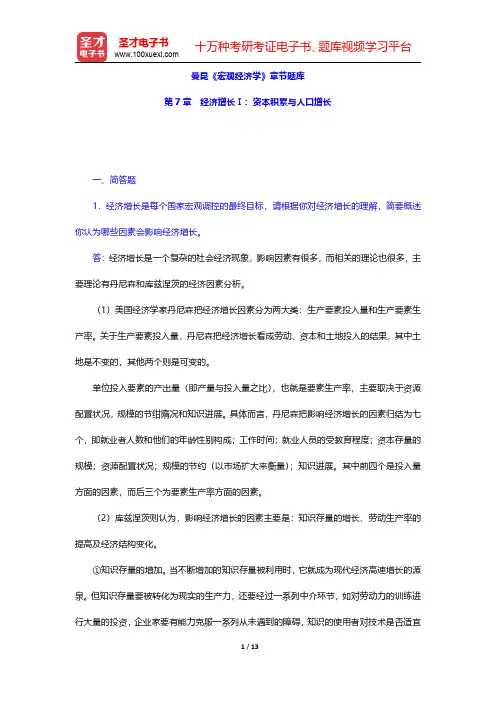
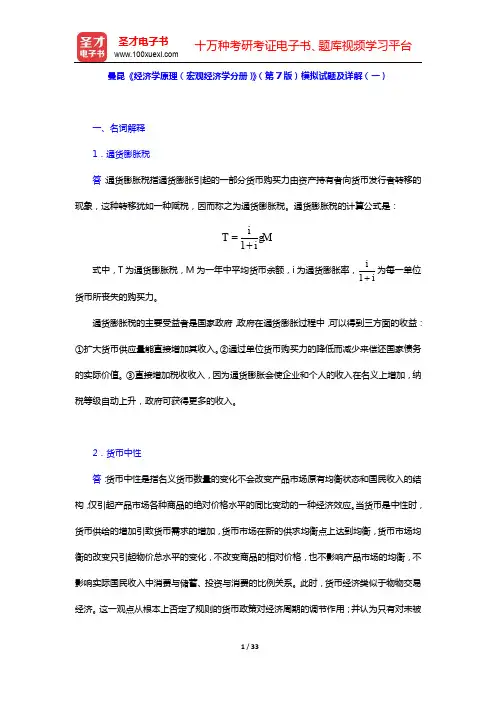
曼昆《经济学原理(宏观经济学分册)》(第7版)模拟试题及详解(一)一、名词解释1.通货膨胀税 答:通货膨胀税指通货膨胀引起的一部分货币购买力由资产持有者向货币发行者转移的现象,这种转移犹如一种赋税,因而称之为通货膨胀税。
通货膨胀税的计算公式是:1i T M i=+g 式中,T 为通货膨胀税,M 为一年中平均货币余额,i 为通货膨胀率,1i i +为每一单位货币所丧失的购买力。
通货膨胀税的主要受益者是国家政府,政府在通货膨胀过程中,可以得到三方面的收益:①扩大货币供应量能直接增加其收入。
②通过单位货币购买力的降低而减少来偿还国家债务的实际价值。
③直接增加税收收入,因为通货膨胀会使企业和个人的收入在名义上增加,纳税等级自动上升,政府可获得更多的收入。
2.货币中性答:货币中性是指名义货币数量的变化不会改变产品市场原有均衡状态和国民收入的结构,仅引起产品市场各种商品的绝对价格水平的同比变动的一种经济效应。
当货币是中性时,货币供给的增加引致货币需求的增加,货币市场在新的供求均衡点上达到均衡,货币市场均衡的改变只引起物价总水平的变化,不改变商品的相对价格,也不影响产品市场的均衡,不影响实际国民收入中消费与储蓄、投资与消费的比例关系。
此时,货币经济类似于物物交易经济。
这一观点从根本上否定了规则的货币政策对经济周期的调节作用;并认为只有对未被预期到的通货膨胀采取适当的货币政策才可以提高实际经济水平。
3.自然率假说答:自然率假说是卢卡斯在“自然失业率”的基础上,提出的一种关于就业、产出以及物价等经济变量存在着一种不由政府政策支配的实际因素(如生产、技术等)决定的自然水平的理论观点。
根据自然率假说,任何一个社会都存在一个自然失业率,其大小取决于社会的技术水平、资源数量和文化传统。
长期而言,经济总是趋向于自然失业率;尽管短期内,经济政策能够使得实际失业率不同于自然失业率。
弗里德曼根据自然率和菲利普斯曲线得出一个货币主义的结论:在短期,虽然可以通过货币政策把失业率人为地维持在小于自然率的水平,但是,在长期不可能做到这一点。
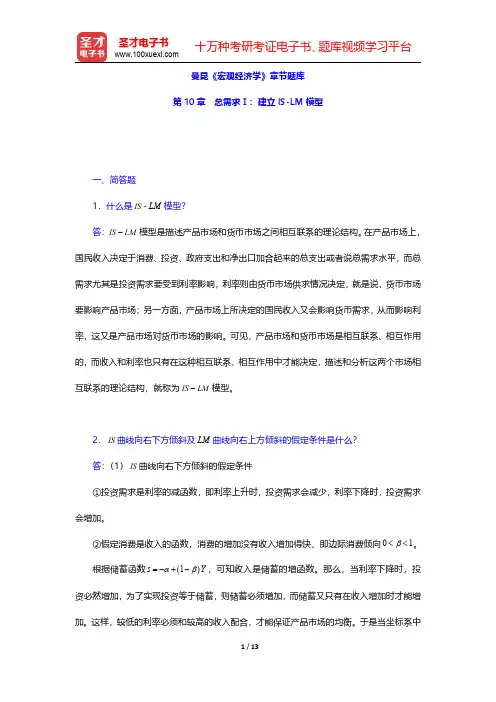
曼昆《宏观经济学》章节题库第10章总需求Ⅰ:建立IS-LM 模型一、简答题1.什么是IS -LM 模型?答:IS LM -模型是描述产品市场和货币市场之间相互联系的理论结构。
在产品市场上,国民收入决定于消费、投资、政府支出和净出口加合起来的总支出或者说总需求水平,而总需求尤其是投资需求要受到利率影响,利率则由货币市场供求情况决定,就是说,货币市场要影响产品市场;另一方面,产品市场上所决定的国民收入又会影响货币需求,从而影响利率,这又是产品市场对货币市场的影响。
可见,产品市场和货币市场是相互联系、相互作用的,而收入和利率也只有在这种相互联系、相互作用中才能决定,描述和分析这两个市场相互联系的理论结构,就称为IS LM -模型。
2.IS 曲线向右下方倾斜及LM 曲线向右上方倾斜的假定条件是什么?答:(1)IS 曲线向右下方倾斜的假定条件①投资需求是利率的减函数,即利率上升时,投资需求会减少,利率下降时,投资需求会增加。
②假定消费是收入的函数,消费的增加没有收入增加得快,即边际消费倾向01β<<。
根据储蓄函数()1s Y αβ=-+-,可知收入是储蓄的增函数。
那么,当利率下降时,投资必然增加,为了实现投资等于储蓄,则储蓄必须增加,而储蓄又只有在收入增加时才能增加。
这样,较低的利率必须和较高的收入配合,才能保证产品市场的均衡。
于是当坐标系中纵轴表示利率,横轴表示收入时,IS曲线就必然向右下方倾斜。
(2)LM曲线向右上方倾斜的假定条件货币需求随利率上升而减少,随收入上升而增加。
如果这些条件成立,则当货币供给既定时,若利率上升,则货币投机需求量减少(即人们认为债券价格下降时,购买债券从投机角度看风险变小,因而人们愿为买进债券而减少持币)。
为保持货币市场上供求平衡,货币交易需求量必须相应增加,而货币交易需求又只有在收入增加时才会增加,于是,较高的利率必须和较高的收入相结合,才能使货币市场均衡。
如果这些条件不成立,则LM曲线不一定向右上方倾斜。
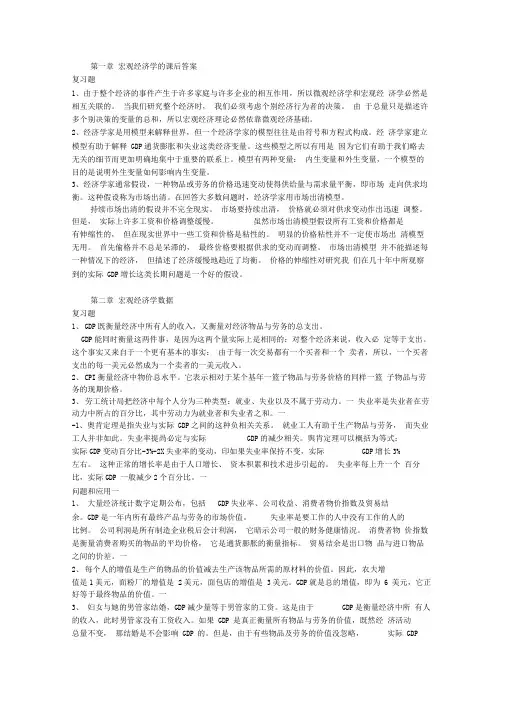

曼昆《宏观经济学》章节题库(货币系统:它是什么?如何起作⽤?)【圣才出品】第4章货币系统:它是什么?如何起作⽤?⼀、判断题1.中央银⾏进⾏100万元政府债券公开市场购买。
如果法定准备⾦率是10%,这会引起增加的货币供给量⾄多为1000万元。
()【答案】T【解析】由于货币乘数是准备⾦率的倒数,由法定准备⾦率为10%,则货币乘数为10,故增加的货币供给量⾄多为100×10=1000万元。
2.M2的范围⼤于M1,流动性也强于M1。
()【答案】F【解析】M2包括储蓄账户和货币市场共同基⾦,其范围⼤于M1,但流动性弱于M1。
3.现⾏的存款准备⾦制度使商业银⾏也具有了创造货币的功能。
()【答案】T【解析】现⾏的存款准备⾦制度是部分准备⾦制度,即银⾏只把它们的部分存款作为准备⾦,商业银⾏因此⽽具备了货币创造的能⼒。
4.相对他们的存款⽽⾔,公众⼿中持有的货币越多,货币乘数就越⼤。
()【答案】F【解析】货币乘数为:m=M/B,其中B是基础货币,M是货币供给量。
公众收⽀持有的货币越多,M越⼩,B越⼤,货币乘数越⼩。
5.如果银⾏决定持有少量存款作为超额准备⾦,在其他条件不变的情况下,货币供给将减少。
()【答案】T【解析】货币供给总额决定于如下四个因素:①基础货币;②通货对存款的⽐率;③法定准备⾦对存款的⽐率;④超额准备⾦对存款的⽐率。
在这四个因素中,基础货币与货币供给正相关,⽽其余三个因素都与货币供给负相关。
6.不考虑现⾦—存款⽐率,货币乘数则等于1除以存款准备⾦率。
()【答案】T【解析】货币乘数为:(cr+1)/(rr+cr),其中cr为现⾦—存款⽐率,rr为存款准备⾦⽐率,若不考虑cr,则货币乘数为:1/rr。
7.古典理论使我们可以不⽤涉及货币供给⽽研究实际变量的决定。
()【答案】T【解析】古典⼆分法的产⽣是因为在古典经济理论中,货币供给的变动不影响实际变量,货币是中性的,因此可以不⽤涉及货币供给⽽研究实际变量的决定。
第七章经济增长Ⅰ:资本积累与人口增长7.1 本章框架结构图7.2 重难点解读索洛增长模型旨在说明在一个经济中,资本存量的增长、劳动力的增长和技术进步如何相互作用,以及它们如何影响一国产品与服务的总产出。
本章强调了资本积累和人口增长的作用。
关于技术进步的作用,第八章予以介绍。
分以下几步来建立索洛增长模型:第一步是考察产品的供求如何决定资本积累。
在这第一步中,假定劳动力和技术是固定不变的。
然后放松这些假设,在本章稍后引进劳动力的变动,在第八章中引入技术进步。
一、资本积累1.产品的供给与生产函数索洛模型中,产品的供给是建立在生产函数基础上的,产出取决于资本存量和劳动力(暂时不考虑技术进步):Y=F(K,L)基于索洛增长模型重要假设:生产函数为规模报酬不变,可得:Y/L=F(K/L,1)令y=Y/L表示人均产出,k=K/L表示人均资本。
这样,可以把生产函数写为:y=f(k)图7-1显示了这一生产函数。
生产函数的斜率是资本的边际产量MPK。
由于存在资本边际产量递减规律,因此,随着资本量的增加,生产函数变得越来越平坦。
图7-1 生产函数资本的边际生产率仅与人均资本水平有关,与投入的绝对规模无关。
对于任何一个给定的资本存量k,生产函数y=f(k)决定了经济的产出水平。
基于上述性质,对总产量、总资本的讨论可转换为对人均产量、人均资本的讨论。
2.产品的需求与消费函数在索洛模型中,产品的需求来自于消费和投资。
人均产出y分为人均消费c和人均投资i:y=c+i索洛模型假设,收入中的s部分用于储蓄,(1-s)部分用于消费。
因此,消费函数表述为:c=(1-s)y式中,储蓄率s为介于0~1之间的一个数,其大小决定了产出在消费和投资之间的分配。
用(1-s)y代替国民收入核算恒等式中的c:y=(1-s)y+i整理可得:i=sy该式表明,投资等于储蓄。
注:(1)供给可以自动地产生需求,使需求永远等于供给。
所以,重点讨论供给方。
(2)消费的选择决定资本存量k的变化,因此会影响下一期的供给。
第一篇导言复习题第一章宏观经济学的科学1、解释宏观经济学和微观经济学之间的差距,这两个领域如何相互关联?【答案】微观经济学研究家庭和企业如何作出决策以及这些决策在市场上的相互作用。
微观经济学的中心原理是家庭和企业的最优化——他们在目的和所面临的约束条件下可以让自己的境况更好。
而相对的,宏观经济学研究经济的整体情况,它主要关心总产出、总就业、一般物价水平和国际贸易等问题,以及这些宏观指标的波动趋势与规律。
应该看到,宏观经济学研究的这些宏观经济变量是以经济体系中千千万万个体家庭和企业之间的相互作用所构成的。
因此,微观经济决策总是构成宏观经济模型的基础,宏观经济学必然依靠微观经济基础。
2、为什么经济学家建立模型?【答案】一般来说,模型是对某些具体事物的抽象,经济模型也是如此。
经济模型可以简洁、直接地描述所要研究的经济对象的各种关系。
这样,经济学家可以依赖模型对特定的经济问题进行研究;并且,由于经济实际不可控,而模型是可控的,经济学家可以根据研究需要,合理、科学的调整模型来研究各种经济情况。
另外,经济模型一般是数学模型,而数学是全世界通用的科学语言,使用规范、标准的经济模型也有利于经济学家正确表达自己的研究意图,便于学术交流。
3、什么是市场出清模型?什么时候市场出清的假设是适用的?【答案】市场出清模型就是供给与需求可以在价格机制调整下很快达到均衡的模型。
市场出清模型的前提条件是价格是具有伸缩性的(或弹性)。
但是,我们知道价格具有伸缩性是一个很强的假设,在很多实际情况下,这个假设都是不现实的。
比如:劳动合同会使劳动力价格在一段时期内具有刚性。
因此,我们必须考虑什么情况下价格具有伸缩性是合适的。
现在一般认为,在研究长期问题时,假设价格具有伸缩性是合理的;而在研究短期问题时,最好假设价格具有刚性。
因为,从长期看,价格机制终将发挥作用,使市场供需平衡,即市场出清,而在短期,价格机制因其他因素制约,难以很快使市场出清。
曼昆宏观经济经济学第九版英文原版答案完整版曼昆宏观经济经济学第九版英文原版答案集团标准化办公室:[VV986T-J682P28-JP266L8-68PNN]A n s w e r s t o T e x t b o o k Q u e s t i o n s a n d P r o b l e m sCHAPTER 7Unemployment and the Labor MarketQuestions for Review1. The rates of job separation and job finding determine the naturalrate of unemployment. The rate of job separation is the fraction of people who lose their job each month. The higher the rate of jobseparation, the higher the natural rate of unemployment. The rate of job finding is the fraction of unemployed people who find a job each month. The higher the rate of job finding, the lower the natural rate of unemployment.2. Frictional unemployment is the unemployment caused by the time ittakes to match workers and jobs. Finding an appropriate job takes time because the flow of information about job candidates and job vacancies is not instantaneous. Because different jobs requiredifferent skills and pay different wages, unemployed workers may not accept the first job offer they receive.In contrast, structural unemployment is the unemployment resulting from wage rigidity and job rationing. These workers are unemployed not because they are actively searching for a job that best suits their skills (as in the case of frictional unemployment), but because at the prevailing real wage thequantity of labor supplied exceeds the quantity of labor demanded. If the wage does not adjust to clear the labor market, then these workers must wait for jobs to become available. Structural unemployment thus arises because firms fail to reduce wages despite an excess supply of labor.3. The real wage may remain above the level that equilibrates laborsupply and labor demand because of minimum wage laws, the monopoly power of unions, and efficiency wages.Minimum-wage laws cause wage rigidity when they prevent wages from falling to equilibrium levels. Although most workers are paid a wage above the minimum level, for some workers, especially the unskilled and inexperienced, the minimum wage raises their wage above theequilibrium level. It therefore reduces the quantity of their labor that firms demand, and creates an excess supply of workers, which increases unemployment.The monopoly power of unions causes wage rigidity because the wages of unionized workers are determined not by the equilibrium of supply and demand but by collective bargaining between union leaders and firm management. The wage agreement often raises the wage abovethe equilibrium level and allows the firm to decide how many workers to employ. These high wages cause firms to hire fewer workers than at the market-clearing wage, so structural unemployment increases.Efficiency-wage theories suggest that high wages make workers more productive. The influence of wages on worker efficiency may explain why firms do not cut wages despite an excess supply of labor. Even though a wage reduction decreasesthe firm’s wage bill, it may also lower worker productivity and therefore the firm’s profits.4. Depending on how one looks at the data, most unemployment can appearto be either short term or long term. Most spells of unemployment are short; that is, most of those who became unemployed find jobs quickly.On the other hand, most weeks of unemployment are attributable to the small number of long-term unemployed. By definition, the long-term unemployed do not find jobs quickly, so they appear on unemployment rolls for many weeks or months.5. Europeans work fewer hours than Americans. One explanation is thatthe higher income tax rates in Europe reduce the incentive to work. A second explanation is a larger underground economy in Europe as aresult of more people attempting to evade the high tax rates.A third explanation is the greater importance of unions in Europe and their ability to bargain for reduced work hours. A final explanation isbased on preferences, whereby Europeans value leisure more thanAmericans do, and therefore elect to work fewer hours.Problems and Applications1. a. In the example that follows, we assume that during the school yearyou look for a part-time job, and that, on average, it takes 2 weeks to find one. We also assume that the typical job lasts 1semester, or 12 weeks.b. If it takes 2 weeks to find a job, then the rate of job finding in weeks isf = (1 job/2 weeks) = 0.5 jobs/week.If the job lasts for 12 weeks, then the rate of job separation in weeks iss = (1 job/12 weeks) = 0.083 jobs/week.c. From the text, we know that the formula for the natural rate of unemployment is(U/L) = [s/(s + f )],where U is the number of people unemployed, and L is the number of people in the labor force.Plugging in the values for f and s that were calculated in part (b), we find(U/L) = [0.083/(0.083 + 0.5)] = 0.14.Thus, if on average it takes 2 weeks to find a job that lasts 12 weeks, the natural rate of unemployment for this population ofcollege students seeking part-time employment is 14 percent.2. Call the number of residents of the dorm who are involved I, thenumber who are uninvolved U, and the total number of students T = I + U. In steady state the total number of involved students is constant.For this to happen we need the number of newly uninvolved students,(0.10)I, to be equal to the number of students who just becameinvolved, (0.05)U. Following a few substitutions:(0.05)U = (0.10)I= (0.10)(T – U),soWe find that two-thirds of the students are uninvolved.3. To show that the unemployment rate evolves over time to thesteady-state rate, let’s begin by defining how the number of people unemployed changes over time. The change in the number of unemployed equals the number of people losing jobs (sE) minus the number finding jobs (fU). In equation form, we can express this as:U–U t= ΔU t + 1 = sE t–fU t.t + 1Recall from the text that L = E t + U t, or E t = L –U t, where L is the total labor force (we will assume that L is constant). Substituting for E t in the above equation, we findΔU t + 1 = s(L –U t) –fU t.Dividing by L, we get an expression for the change in the unemployment rate from t to t + 1:ΔU t + 1/L = (U t + 1/L) –(U t/L) = Δ[U/L]t + 1 = s(1 –U t/L) –fU t/L.Rearranging terms on the right side of the equation above, we end up with line 1 below. Now take line 1 below, multiply the right side by (s + f)/(s + f) and rearrange terms to end up with line 2 below:Δ[U/L]t + 1= s – (s + f)U t/L= (s + f)[s/(s + f) – U/L].tThe first point to note about this equation is that in steady state, when the unemployment rate equals its natural rate, the left-handside of this expression equals zero. This tells us that, as we found in the text, the natural rate of unemployment (U/L)n equals s/(s + f).We can now rewrite the above expression, substituting (U/L)n for s/(s + f), to get an equation that is easier to interpret: Δ[U/L]t + 1 = (s + f)[(U/L)n–U t/L].This expression shows the following:If U t/L > (U/L)n (that is, the unemployment rate is above its natural rate), then Δ[U/L]t + 1 is negative: the unemployment rate falls.If U t/L < (U/L)n (that is, the unemployment rate is below its natural rate), then Δ[U/L]t + 1 is positive: the unemployment raterises.This process continues until the unemployment rate U/L reaches the steady-state rate (U/L)n.4. Consider the formula for the natural rate of unemployment,If the new law lowers the chance of separation s, but has no effect on the rate of job finding f, then the natural rate of unemployment falls.For several reasons, however, the new law might tend to reduce f.First, raising the cost of firing might make firms more careful about hiring workers, since firms have a harder time firing workers who turn out to be a poor match. Second, if job searchers think that the new legislation will lead them to spend a longer period of time on a particular job, then they might weigh morecarefully whether or not to take that job. If the reduction in f is large enough, then the new policy may even increase the natural rate of unemployment.5. a. The demand for labor is determined by the amount of labor that aprofit-maximizing firm wants to hire at a given real wage. The profit-maximizing condition is that the firm hire labor until the marginal product of labor equals the real wage,The marginal product of labor is found by differentiating the production function with respect to labor (see Chapter 3 for more discussion),In order to solve for labor demand, we set the MPL equal to the real wage and solve for L:Notice that this expression has the intuitively desirable feature that increases in the real wage reduce the demand for labor.b. We assume that the 27,000 units of capital and the 1,000 units oflabor are supplied inelastically (i.e., they will work at anyprice). In this case we know that all 1,000 units of labor and 27,000 units of capital will be used in equilibrium, so we can substitute these values into the above labor demand function and.solve for WPIn equilibrium, employment will be 1,000, and multiplying this by10 we find that the workers earn 10,000 units of output. The totaloutput is given by the production function:Y=5Y13Y23Y=5(27,00013)(1,00023)Y=15,000.Notice that workers get two-thirds of output, which is consistent with what we know about the Cobb–Douglas production function from Chapter 3.c. The real wage is now equal to 11 (10% above the equilibrium levelof 10).Firms will use their labor demand function to decide how manyworkers to hire at the given real wage of 11 and capital stock of 27,000:So 751 workers will be hired for a total compensation of 8,261units of output. To find the new level of output, plug the new value for labor and the value for capital into the production function and you will find Y = 12,393.d. The policy redistributes output from the 249 workers who becomeinvoluntarily unemployed to the 751 workers who get paid more than before. The lucky workers benefit less than the losers lose as the total compensation to the working class falls from 10,000 to 8,261 units of output.e. This problem does focus on the analysis of two effects of theminimum-wage laws: they raise the wage for some workers whiledownward-sloping labor demand reduces the total numberof jobs.Note, however, that if labor demand is less elastic than in this example, then the loss of employment may be smaller, and thechange in worker income might be positive.6. a. The labor demand curve is given by the marginal product of laborschedule faced by firms. If a country experiences a reduction inproductivity, then the labor demand curve shifts to the left as in Figure 7-1. If labor becomes less productive, then at any givenreal wage, firms demand less labor.b. If the labor market is always in equilibrium, then, assuming afixed labor supply, an adverse productivity shock causes adecrease in the real wage but has no effect on employment orunemployment, as in Figure 7-2.c. If unions constrain real wages to remain unaltered, then asillustrated in Figure 7-3, employmentfalls to L1 and unemployment equals L –L1.This example shows that the effect of a productivity shock on aneconomy depends on the role of unions and the response of collective bargaining to such a change.7. a. If workers are free to move between sectors, then the wage in each sector will be equal. If thewages were not equal then workers would have an incentive to move to the sector with the higherwage and this would cause the higher wage to fall, and the lower wage to rise until they wereequal.b. Since there are 100 workers in total, L S = 100 – L M. We cansubstitute this expression into the labor demand for services equation, and call the wage w since it is the same in bothsectors:L S = 100 – LM= 100 – 4wLM= 4w.Now set this equal to the labor demand for manufacturing equation and solve for w:4w = 200 – 6ww = $20.Substitute the wage into the two labor demand equations to find L M is 80 and L S is 20.c. If the wage in manufacturing is equal to $25 then L M is equal to 50.d. There are now 50 workers employed in the service sector and the wage w S is equal to $12.50.e. The wage in manufacturing will remain at $25 and employment will remain at 50. If thereservation wage for the service sector is $15 then employment in the service sector will be 40. Therefore, 10 people are unemployed and the unemployment rate is 10 percent.8. Real wages have risen over time in both the United Statesand Europe,increasing the reward for working (the substitution effect) but also making people richer, so they want to “buy” more leisure (theincome effect). If the income effect dominates, then people want to work less as real wages go up. This could explain the Europeanexperience, in which hours worked per employed person have fallen over time. If the income and substitution effects approximatelycancel, then this could explain the U.S. experience, in which hours worked per person have stayed about constant. Economists do not have good theories for why tastes might differ, so they disagree onwhether it is reasonable to think that Europeans have a larger income effect than do Americans.9. The vacant office space problem is similar to the unemploymentproblem; we can apply the same concepts we used in analyzingunemployed labor to analyze why vacant office space exists. There isa rate of office separation: firms that occupy offices leave, eitherto move to different offices or because they go out of business.There is a rate of office finding: firms that need office space (either to start up or expand) find empty offices. It takes time to match firms with available space. Different types of firms require spaces with different attributes depending on what theirspecific needs are. Also, because demand for different goods fluctuates, there are “sectoral shifts”—changes in the composition of demand among industries and regions that affect the profitability and office needs of different firms.。
第一篇导言复习题第一章宏观经济学的科学1、解释宏观经济学和微观经济学之间的差距,这两个领域如何相互关联?【答案】微观经济学研究家庭和企业如何作出决策以及这些决策在市场上的相互作用。
微观经济学的中心原理是家庭和企业的最优化——他们在目的和所面临的约束条件下可以让自己的境况更好。
而相对的,宏观经济学研究经济的整体情况,它主要关心总产出、总就业、一般物价水平和国际贸易等问题,以及这些宏观指标的波动趋势与规律。
应该看到,宏观经济学研究的这些宏观经济变量是以经济体系中千千万万个体家庭和企业之间的相互作用所构成的。
因此,微观经济决策总是构成宏观经济模型的基础,宏观经济学必然依靠微观经济基础。
2、为什么经济学家建立模型?【答案】一般来说,模型是对某些具体事物的抽象,经济模型也是如此。
经济模型可以简洁、直接地描述所要研究的经济对象的各种关系。
这样,经济学家可以依赖模型对特定的经济问题进行研究;并且,由于经济实际不可控,而模型是可控的,经济学家可以根据研究需要,合理、科学的调整模型来研究各种经济情况。
另外,经济模型一般是数学模型,而数学是全世界通用的科学语言,使用规范、标准的经济模型也有利于经济学家正确表达自己的研究意图,便于学术交流。
3、什么是市场出清模型?什么时候市场出清的假设是适用的?【答案】市场出清模型就是供给与需求可以在价格机制调整下很快达到均衡的模型。
市场出清模型的前提条件是价格是具有伸缩性的(或弹性)。
但是,我们知道价格具有伸缩性是一个很强的假设,在很多实际情况下,这个假设都是不现实的。
比如:劳动合同会使劳动力价格在一段时期内具有刚性。
因此,我们必须考虑什么情况下价格具有伸缩性是合适的。
现在一般认为,在研究长期问题时,假设价格具有伸缩性是合理的;而在研究短期问题时,最好假设价格具有刚性。
因为,从长期看,价格机制终将发挥作用,使市场供需平衡,即市场出清,而在短期,价格机制因其他因素制约,难以很快使市场出清。
第12章总需求Ⅱ:应用IS-LM模型一、名词解释1.财政政策(暨南大学2017研;浙江理工大学2015研;上海大学2014研;青岛理工大学2014研;东北财大2006研;东北大学2004研)答:财政政策是指政府变动税收和支出以便影响总需求进而影响就业和国民收入的政策。
变动税收是指改变税率和税率结构。
变动政府支出指改变政府对商品与劳务的购买支出以及转移支付。
它是利用政府预算(包括税收和政府支出)来影响总需求,从而达到稳定经济目的的宏观经济政策。
其特点是政府用行政预算来直接控制消费总量和投资总量,调节国家的需求水平,使总需求和总供给达到理想的均衡状态,从而促进充分就业和控制通货膨胀。
从其内容上看,包括财政收入政策和财政支出政策。
前者的政策手段主要是税率,后者的政策手段主要是政府购买(支出)。
从对经济发生作用的结果上看,财政政策分为扩张性的财政政策和紧缩性的财政政策。
前者是指降低税率、增加转移支付、扩大政府支出,目的是刺激总需求,以降低失业率。
后者则包括提高税率、减少转移支付、降低政府支出,以此抑制总需求的增加,进而遏制通货膨胀。
财政政策是需求管理的一种主要手段。
2.凯恩斯陷阱(中央财大2019、2011、2008研;人大2017研;西安交大2004研;上海交大2003研;北大2001研)答:凯恩斯陷阱又称流动性陷阱或灵活陷阱,是凯恩斯的流动偏好理论中的一个概念,具体是指当利率水平极低时,人们对货币需求趋于无限大,货币当局即使增加货币供给也不能降低利率,从而不能增加投资引诱的一种经济状态。
当利率极低时,有价证券的价格会达到很高,人们为了避免因有价证券价格跌落而遭受损失,几乎每个人都宁愿持有现金而不愿持有有价证券,这意味着货币需求会变得完全有弹性,人们对货币的需求量趋于无限大,表现为流动偏好曲线或货币需求曲线的右端会变成水平线。
在此情况下,货币供给的增加不会使利率下降,从而也就不会增加投资引诱和有效需求,当经济出现上述状态时,就称之为流动性陷阱。
1 / 154 十万种考研考证电子书、题库视频学习平台 圣才电子书 www.100xuexi.com 第1篇 导 言
第1章 宏观经济学科学 一、概念题 1.宏观经济学(macroeconomics) 答:宏观经济学与微观经济学相对,是一种现代的经济分析方法。它以国民经济总体作为考察对象,研究经济生活中有关总量的决定与变动,解释失业、通货膨胀、经济增长与波动、国际收支及汇率的决定与变动等经济中的宏观整体问题,所以又称之为总量经济学。宏观经济学的中心和基础是总需求—总供给模型。具体来说,宏观经济学主要包括总需求理论、总供给理论、失业与通货膨胀理论、经济增长与经济周期理论、开放经济理论、宏观经济政策等内容。 对宏观经济问题进行分析与研究的历史十分悠久,但现代意义上的宏观经济学直到20世纪30年代才得以形成和发展起来。现代宏观经济学诞生的标志是凯恩斯于1936年出版的《就业、利息和货币通论》。宏观经济学在20世纪30年代奠定基础,二战后逐步走向成熟并得到广泛应用,20世纪60年代后的“滞胀”问题使凯恩斯主义的统治地位受到严重挑战并形成了货币主义、供给学派、理性预期等学派对立争论的局面,20世纪90年代新凯恩斯主义的形成又使国家干预思想占据主流。宏观经济学是当代发展最为迅猛,应用最为广泛,因而也是最为重要的经济学学科。
2.实际GDP(real GDP) 答:实际GDP指用以前某一年的价格作为基期的价格计算出来的当年全部最终产品的 2 / 154
十万种考研考证电子书、题库视频学习平台 圣才电子书 www.100xuexi.com 市场价值。它衡量在两个不同时期经济中的产品产量变化,以相同的价格或不变金额来计算
两个时期所生产的所有产品的价值。在国民收入账户中,以2010年的价格作为基期来计算实际GDP,意味着在计算实际GDP时,用现期的产品产量乘以2010年的价格,便可得到以2010年价格出售的现期产出的价值。
3.通货膨胀与通货紧缩(inflation and deflation) 答:(1)通货膨胀是指在一段时期内,一个经济中大多数商品和劳务的价格水平持续显著地上涨。它包含三层含义:①通货膨胀是经济中一般价格水平的上涨,而不是个别商品或劳务的价格上涨;②通货膨胀是价格的持续上涨,而非一次性上涨;③通货膨胀是价格的显著上涨,而非某些微小的上升,例如每年上升0.5%,不能视为通货膨胀。 通货膨胀的严重程度一般用通货膨胀率来衡量。根据不同标准,可以把通货膨胀划分为不同类型。根据通货膨胀的表现形式,可分为公开型通货膨胀和隐蔽型通货膨胀;根据通货膨胀的严重程度,可分为爬行式通货膨胀、奔跑式通货膨胀和恶性通货膨胀;根据通货膨胀发生的原因,可分为需求拉上型通货膨胀、成本推动型通货膨胀、混合型通货膨胀和结构型通货膨胀;根据通货膨胀是否被预期,可分为预期型通货膨胀和未预期型通货膨胀。 (2)通货紧缩是与通货膨胀相对立的概念,是指在一段时期内,一个经济体中一般商品和劳务价格的持续显著地下降。 通货紧缩从本质上来说是一种货币现象,它在实体经济中的根源是总需求对总供给的偏离,或现实经济增长率对潜在经济增长率的偏离。当总需求持续小于总供给,或现实经济增长率持续低于潜在经济增长率时,就会出现通货紧缩现象。 通货紧缩的特征是物价水平的持续下跌。这个物价水平,严格说来应包括资产价格如股票、债券、房地产及商品和服务在内的价格指数,但碍于统计上的局限性,一般在国内用全 3 / 154
十万种考研考证电子书、题库视频学习平台 圣才电子书 www.100xuexi.com 国零售物价上涨率,在国外用消费价格指数(CPI)作为度量指标。如果全国零售物价上涨
率在零以下且持续时间超过6个月,人们通常在理论上就将其界定为典型的通货紧缩。 通货紧缩也是一种实体经济现象。它通常与经济衰退相伴随,表现为投资机会相对减少和投资的边际收益下降,由此造成银行信用紧缩,货币供应量增长持续下降,信贷增长乏力,消费和投资需求减少,企业普遍开工不足,非自愿失业增加,收入增长速度持续放慢,各个市场普遍低迷。
4.失业率(unemployment rate) 答:失业率衡量没有工作的劳动力所占的比例。就业者和失业者的总和称为劳动力,失业者占劳动力的百分比就是失业率。经济在长期中处于的失业率称为自然失业率,当经济中的失业率等于自然失业率时就称经济处于充分就业水平。
5.衰退(recession) 答:衰退是指实际GDP减少,但不严重的时期,一般的衡量标准是国民生产总值连续两个季度下降。一个完整的经济周期包括繁荣、衰退、萧条和复苏四个阶段。在繁荣阶段,经济活动全面扩张,不断达到新的高峰;在衰退阶段,经济在短时间保持均衡后出现紧缩的趋势;在萧条阶段,经济出现急剧的收缩和下降,很快从活动量的最高点下降到最低点;在复苏阶段,经济从最低点恢复并逐渐上升到先前的活动量高度,进入繁荣。
6.萧条(depression) 答:萧条是指实际GDP严重减少的时期。一个完整的经济周期包括繁荣、衰退、萧条和复苏四个阶段。在繁荣阶段,经济活动全面扩张,不断达到新的高峰;在衰退阶段,经济 4 / 154
十万种考研考证电子书、题库视频学习平台 圣才电子书 www.100xuexi.com 在短时间保持均衡后出现紧缩的趋势;在萧条阶段,经济出现急剧的收缩和下降,很快从活
动量的最高点下降到最低点;在复苏阶段,经济从最低点恢复并逐渐上升到先前的活动量高度,进入繁荣。
7.模型(models) 答:模型是指用来描述所研究的经济事物的有关经济变量之间相互关系的理论结构,是现代经济理论的一种主要分析方法,也称为经济数学模型,指用数学形式所表述的经济过程或经济理论结构。 其特点是:以所要研究的问题为中心,从错综复杂的经济现象中概括出一些变量,设立某些假设前提,并根据一定的经济理论把这些变量列成一定的方程式或方程式体系,以表示各经济变量之间的关系,反映经济过程的运行情况,模拟在不同的经济条件下经济主体的行为,同时据以分析过去和现在并预测未来。现实世界的情况是由各种主要变量和次要变量构成的,因而非常复杂,只有把次要因素排除在外,才能对经济运行进行严格的分析。运用经济模型,事先作出某些假设,可以排除掉许多次要因素,从而建立起一定的模型,然后通过运用这一模型,可以对错综复杂的现实世界作出极其简单的描述。
8.内生变量(endogenous variables) 答:内生变量又称为非政策性变量,是指在经济机制内部由纯粹的经济因素所决定的,不为政策所左右的变量。内生变量是“一种理论内所要解释的变量”。内生变量是由模型系统决定的,同时也对模型系统产生影响。内生变量一般都是经济变量,如市场经济中的价格、利率、汇率等变量。 5 / 154
十万种考研考证电子书、题库视频学习平台 圣才电子书 www.100xuexi.com 9.外生变量(exogenous variables)
答:外生变量又称政策性变量,是指在经济机制中受外部因素主要是政策因素影响,而由非经济体系内部因素所决定的变量。这种变量通常能够由政策控制,并以之作为政府实现其政策目标的变量。从广义上讲,任何一个系统(或模型)中都存在许多变量,其中自变量和因变量统称为内生变量,而作为给定条件存在的变量则称为外生变量,指不受自变量影响而受外部条件支配的变量。外生变量一般是确定性变量,或者是具有临界概率分布的随机变量,其参数不是模型系统研究的元素。外生变量影响系统,但本身不受系统的影响。外生变量一般是经济变量、条件变量、政策变量和虚拟变量。 在经济模型中,变量分为内生变量和外生变量。外生变量是由模型以外的因素所决定的变量,本身不能由模型解释。内生变量是一个模型要解释的变量。外生变量决定内生变量,外生变量的变化会引起内生变量值的变化。参数通常是由模型以外的因素决定的,参数也可以被看成是外生变量。例如,在下面均衡价格决定模型中:
dQaP
SQP
dSQQ
Q和P是模型所要决定其数值的变量,称为内生变量。α,β,δ,γ的数值是由模型的外部条件所决定的,被称为外生变量,也被称为参数。外生变量α,β,δ,γ的数值,将决定内生变量Q和的值。
10.市场出清(market clearing) 答:市场出清指商品市场与要素市场同时实现供求平衡的市场状态。作为经济学分析的一个重要假说,该假说认为,市场上价格机制的自我调节能够让市场自发的实现供求均衡,
P 6 / 154
十万种考研考证电子书、题库视频学习平台 圣才电子书 www.100xuexi.com 即市场出清的状态。在商品市场上,价格随供求关系的变动而迅速变动,即供大于求时,价
格迅速下降;供小于求时,价格迅速上升。通过价格迅速的调节,商品市场可以经常处于供求平衡的出清状态。同样,要素市场上,要素价格随要素供求关系的变动而迅速变动,即供大于求时,要素价格迅速下降;供小于求时,价格迅速上升。通过要素价格迅速的调节,要素市场可以经常处于供求平衡的出清状态。当商品市场与要素市场都出清时,经济处于充分就业状态。 市场出清假说的基本前提是价格与工资具有完全的弹性。凯恩斯主义以前的新古典经济学家根据这一假说证明了市场调节的完善性以及充分就业的必然性。凯恩斯主义的出现否认了市场出清假说,论证了如果仅仅依靠市场调节,经济中必然存在失业与生产过剩的危机,并提出了国家干预经济的政策主张。20世纪70年代初出现于经济学界的理性预期学派又重新接受了市场出清假说,并把它与理性预期假说作为基本前提来分析宏观经济的运行,证明市场机制的完善性。
11.弹性价格和黏性价格(flexible and sticky prices) 答:弹性价格是指可以对供求变动作出即时调整的价格,反之,调整比较缓慢的价格被称为黏性价格。古典经济学派认为商品或劳务的价格是有弹性的,因此市场总能处于出清状态,经济总能实现充分就业。但凯恩斯学派则认为价格不是完全有弹性的,而是存在黏性,因此在短期内经济会偏离充分就业水平。
12.微观经济学(microeconomics) 答:微观经济学与宏观经济学相对应,是主要以家庭、厂商(企业)和市场等单个经济主体及其相互关系为研究对象的经济学。微观经济学是以市场经济中各个经济单位的经济行